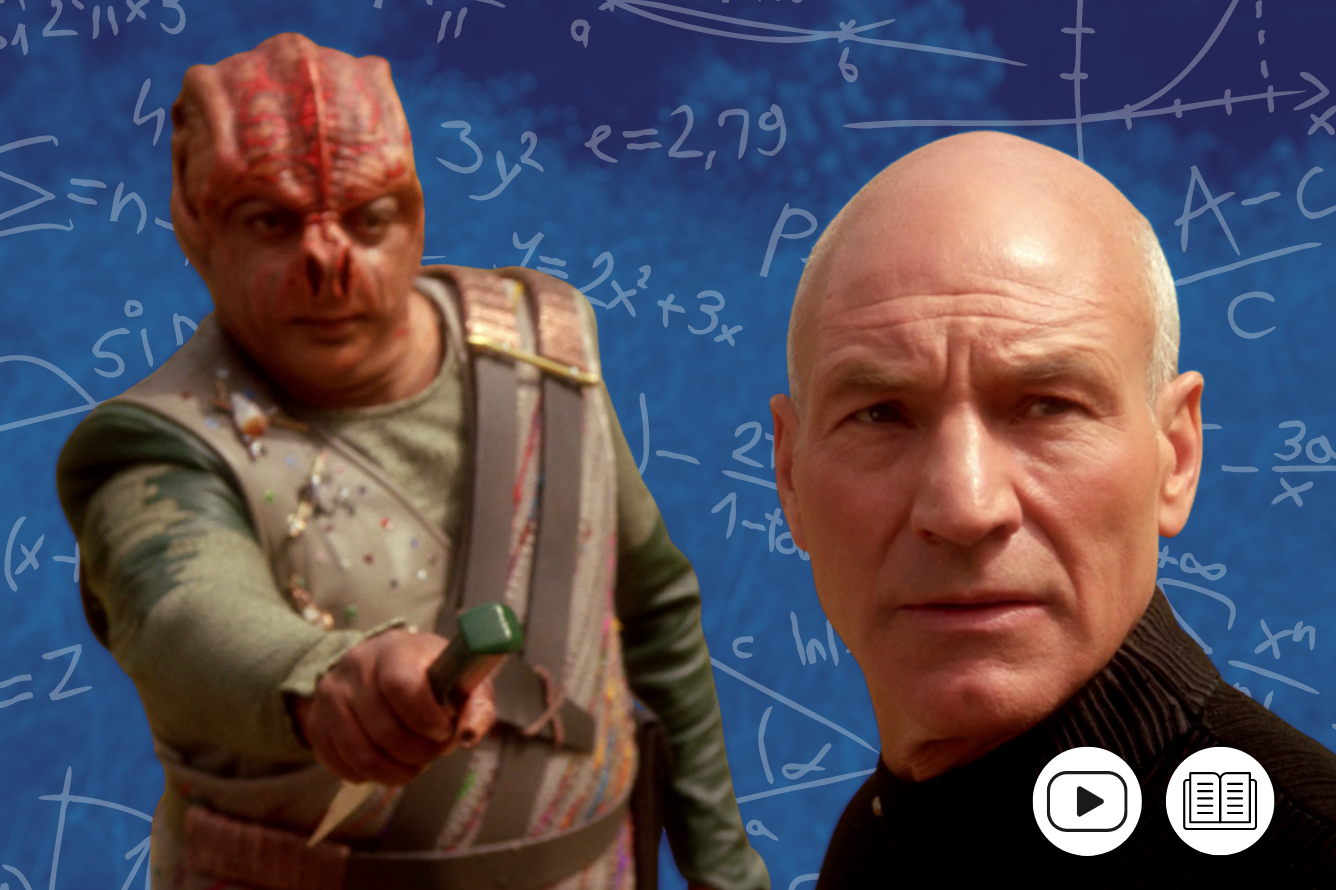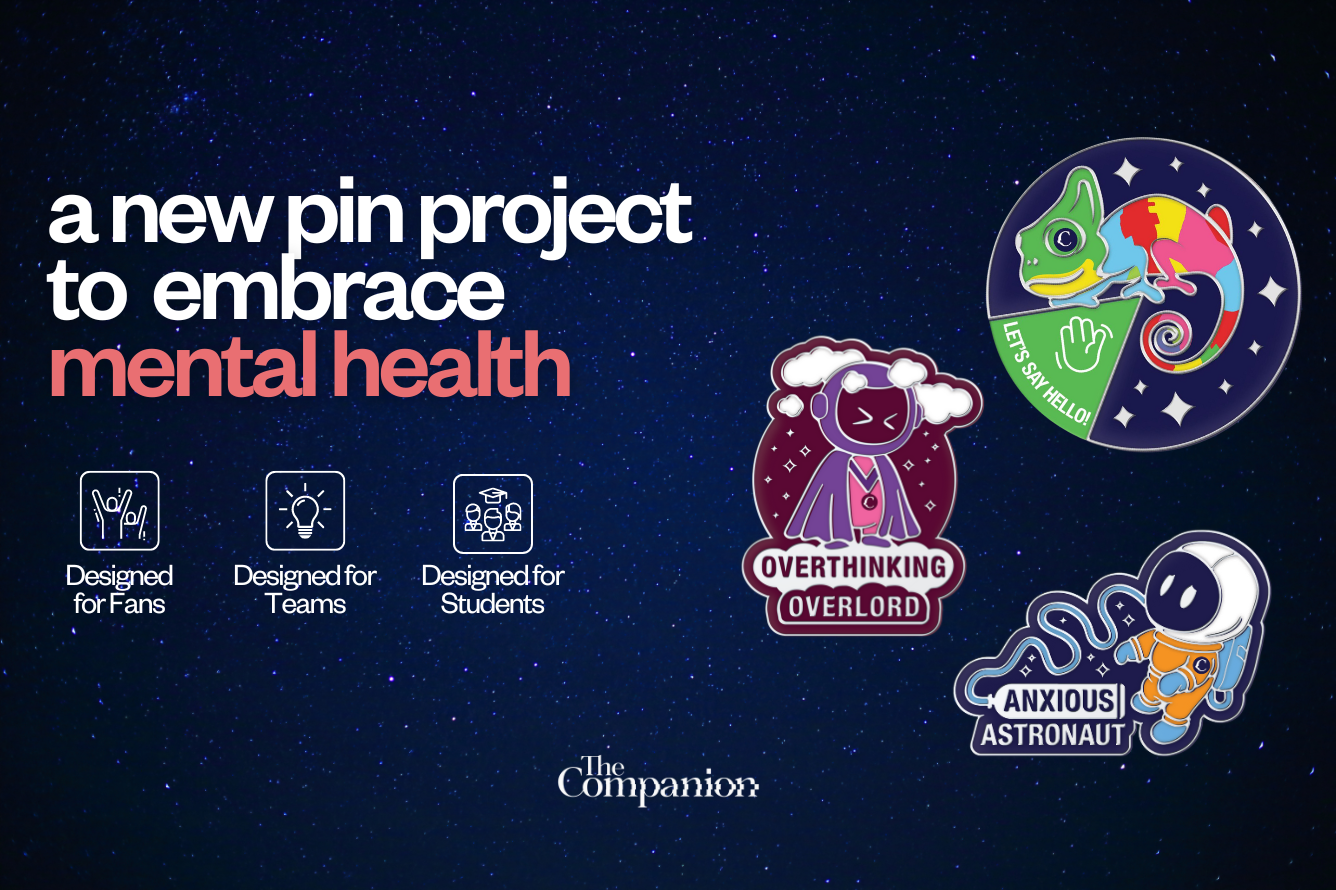Imagine the boundary between science fiction and science fact disappears, just for a few minutes. In that time, you can reach through and pick out a piece of tech from the Trek-iverse to keep. What do you choose?
Maybe a tricorder to diagnose and treat illnesses; a phaser for super realistic cosplaying (please, set it to stun first); if you move quickly, you could prise a replicator off the wall for your very own endless supply of earl grey tea.
But me, I’d reach for a communicator badge. Because not only is tapping a handy way to communicate after years of staring down at a screen, but the universal translator built inside is extremely impressive.
It’s a plot device that’s pivotal to Trek and a lot of other space-faring stories.
Because if you’re wearing a comms badge with Trek’s universal translator (or UT for short) built-in, you can hear any language (okay, most languages) translated into your native tongue in real-time. As you can imagine, this is incredibly handy when you’re regularly encountering species from all over the galaxy.
A Quick History of the Universal Translator
The universal translator was built into comms badges from the 24th century Star Trek: The Next Generation era onwards – in one episode, Riker (Jonathan Frakes) and Troi (Marina Sirtis) even have translators implanted under their skin (‘Who Watches the Watchers’ – S3, Ep4). Before that, it was integrated into starship computers but could only be used on away missions in the form of handheld gadgets or tiny wearable devices.

How does the universal translator work exactly? Well, we’ve heard several brief explanations throughout the history of Trek – and a fair few inconsistencies. One of the earliest is in Star Trek: The Original Series when the translator looks like a metal tube. Captain Kirk (William Shatner) explains that it scans brain wave frequencies to identify universal concepts, then translates instantly (‘Who Mourns for Adonais?’ – S2, Ep2).
However, what you end up hearing isn’t a translated version of the voice of the alien standing in front of you. You hear the words that the UT can replace… somehow.
As with a lot of tech and science in Trek, we need to suspend our disbelief to get our heads around universal translators. What about the way an alien’s mouth moves? How come the UT can translate languages humans have never encountered before? Luckily, the universal translator often blends into the background of Star Trek, so these questions don’t ruin the stories for most of us.

Other species have universal translators that work similarly, like the Ferengi, who originally had handheld devices but then developed in-ear translators. It makes sense that most other species have their own translation tech or that Starfleet’s UTs can sometimes work both ways.
Why The Universal Translator Is So Important
Universal translators are a vital storytelling tool. It wouldn’t make a compelling show if characters relied on a glitchy app, had to rifle through a paper dictionary, or played awkward charades and pointed at things every time they bumped into a new species.
When the UT is embedded into the communicator badge and becomes part of the uniform, it puts the issue of language into the background. Because we don’t think about it much or just assume it works seamlessly, it becomes exciting when Star Trek’s translating tech doesn’t work. Then it becomes central to the story.

This happens a few times throughout Star Trek’s history. In Star Trek: Discovery’s ‘An Obol for Charon’ (S2, Ep4), a mysterious sphere causes interference that screws up the universal translator within the ship’s computer, translating speech into all kinds of languages at random. The crew thinks it might be a computer virus, but it turns out the sphere is trying to communicate with the ship, hoping to pass on all of the information it has accumulated over its lifespan of hundreds of thousands of years before it dies.
As soon as you remove the ability to translate anything and everything on the fly, it becomes clear how integral a universal translator is to the plot of Trek – whether it’s in a computer, a comm badge, or under the skin.
That’s why it’s no surprise how often universal translators show up in other science-fiction stories. The ‘microsoft’ in William Gibson’s novel Neuromancer (and further explored in several of his other novels) is a small chip you can plug into a socket behind your ear. It directly interfaces with your brain and gives you knowledge, skills, and computational ability to translate one language into another.

There are also organic examples like the translator microbes in Farscape. Bacteria injected into your brain allow you to understand any spoken language. And the ‘babel fish’ in The Hitchhiker’s Guide to the Galaxy is “small, yellow and leech-like, and probably the oddest thing in the Universe”. Pop one in your ear, and it feeds on brain waves, translating any language you hear into your native tongue by excreting it out into your ear, eugh.
Will We Ever Have a Universal Translator?
We’re not all wearing translating comms badges in the real world, and we haven’t discovered a babel fish (yet). But translation tech is still impressive and continues to advance.
There are many apps that you can speak into or type text into, which then translate the words for you in seconds. Granted, they cannot translate conversations in real-time, but that’s still a lot of translation power in your pocket.
One of the best apps is Google Translate. Google’s neural translation tech supports 108 languages and is one of the most powerful, accurate, and accessible translation tools today. As well as translating written and spoken language, you can point your device at the text to translate it – an excellent way to quickly decipher a sign or a menu – and draw text characters.
There are also several translation devices that you can wear in your ear. The Google Pixel Buds are a pair of true wireless earbuds that allow you to play music and take calls. But they also work with the Google Translate app, allowing you to hear spoken language translated into your ear in your native tongue.
Other devices are solely dedicated to translation. The brand Timekettle has made a number of these, including the WT2. These are a pair of true wireless earbuds. You wear one, and the person you want to talk to wears another. Your words are translated in their ear as you speak, and vice versa. The WT2 can translate more than 20 languages, has a high accuracy rate, and only takes between 1 and 3 seconds to translate most words.
To understand the tech that powers modern-day translation and where it might be headed, I spoke to Laurence Moroney, lead artificial intelligence advocate at Google and father of our very own Stargate A.I. “It’s getting better all the time,” he tells me. “AI [artificial intelligence] and ML [machine learning] have been a source of major breakthroughs.”
He says that before AI and ML, translation was carried out word-to-word – the tech equivalent of flipping through a dictionary to decipher a sentence. This can be useful but often leads to misunderstandings. Language isn’t simply about our words, there’s more at play, like context, culture, and different syntax.
Moroney says that one of the biggest problems is slang. “If I were to share ‘that man is wearing a green hat’ in Cantonese, the meaning and the gist of the phrase would be there, but the meaning would be very different,” he says. “That’s because in Cantonese’ wearing a green hat’ is slang for ‘his wife is cheating on him’.”

The problems with translation are explored brilliantly in the infamous ‘Darmok’ episode of Star Trek: The Next Generation (S5, Ep3). This is about the Tamarians, a race that uses metaphor to communicate, which makes no sense to the crew of Enterprise-D. Sure, the computer effectively translates each word they say accurately. But without the knowledge of the Tamarian’s style of communication and their history and myths (which their metaphors draw heavily), it proves challenging to understand the meaning.
Moroney tells me that this is why natural language processing (NLP) is essential. A branch of AI that helps computers better understand how humans write and speak.
“NLP techniques in AI map words and phrases into a higher dimensional vector space, and over time meanings and sentiment can be established from these vectors,” he says. “Then, words in the same vector space in another language can be mapped to the ones in our language. And thus translation of semantics can happen. It’s really exciting.”
If that’s what’s being developed right now, what can we expect from the future? “More accurate translations for sure,” Moroney says. “And when they get faster, close to real-time, and predictive, then it gets interesting.”
The big question is: will we ever get a Star Trek-like experience? “Yes and no,” Moroney tells me. He says the big problem with Star Trek’s fictional tech is that the translation happens before sentences finish.
“In some languages, you don’t know what the sentence is about – in particular, the action verb – because it’s at or close to the end of the sentence,” he explains. “So to expect an accurate translation while the person is speaking may never be possible. A short delay – when they finish a sentence – may be possible.”
However, he says “this stuff is really close” in other ways.” To illustrate this, Moroney shares a video from Google to show where we’re at today with dubbing translation – making the experience much more like what we see in Trek.
“I don’t speak a word of Spanish, but they did a machine translation of my words into Spanish. Then had a human translator ensure the quality of the translation,” he explains. “Then used an artificial voice that was trained using Wavenet on *my* voice. Finally, we used lip-sync technology to map my lips to the new voice so that it could look like the video is of me speaking Spanish!”
Is a Universal Translator the Key to Trek’s Utopia?
There are many reasons why the future imagined in Trek seems like a lovely place to be (well, for the most part). It’s hinted that one primary reason everyone on the planet got their act together is due to universal translation.
This is a stark contrast to Douglas Adams’ ‘babel fish’. In The Hitchhiker’s Guide to the Galaxy, he writes that, by removing barriers to communication, the fish has “caused more and bloodier wars than anything else in the history of creation.”
So which is it? Could better translation in the future help us or hinder us? Where the world is right now, it seems we have far too many problems that we wouldn’t simply overcome with better communication. But it can be reassuring to look at Star Trek for a hopeful framework about how we could change things for the better with both the help of new tech and a deeper appreciation of each other.
Thinking back to ‘Darmok’, it was only thanks to Picard’s devotion to understanding and learning from the Tamarian Captain Dathon that led to a breakthrough in language and meaning. “In my experience, communication is a matter of patience, imagination,” he says at the beginning of the episode – and, boy, was his patience tested.

We’ve already learned that translation isn’t simply about replacing one word for another. It only leads to effective communication when you learn more about who you’re talking to and their experience of the world. What’s more, learning that the Tamarians speak in metaphor only unlocked part of the puzzle. Picard also needed to take the time to understand the context and the nature of the myths and stories.
Interestingly, this episode isn’t only about better-understanding others, but better understanding ourselves. I like that, at the very end, Picard is reading a book about Greek myth. “For the next time we encounter the Tamarians,” he tells Riker. “More familiarity with our own mythology might help us relate to theirs.”
I believe this is what the positive and largely peaceful future imagined in Trek is rooted in. An understanding, acceptance, and embracing of differences that starts on Earth and is then extended out to everyone else in the galaxy. Or, as the Tamarians would say, Darmok and Jalad at Tanagra. But without this understanding, well, then Shaka when the walls fell.
This article was first published on April 13th, 2022 on the original Companion website.
The cost of your membership has allowed us to mentor new writers and allowed us to reflect the diversity of voices within fandom. None of this is possible without you. Thank you. 🙂









